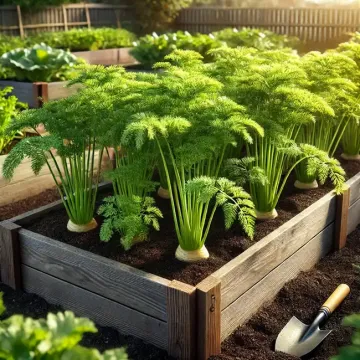Parsnips are a delicious and versatile root vegetable that are often underappreciated in home gardens. With their sweet, earthy flavor and ability to thrive in colder weather, parsnips can be a rewarding crop for gardeners. In this article, we’ll explore the history of parsnips, their health benefits, culinary uses, and tips for successfully growing them in your home garden.
History of Parsnips
Parsnips (Pastinaca sativa) have a long history of cultivation, dating back to ancient civilizations. Native to Eurasia, they were a staple in the diets of the Romans and Greeks. Parsnips were widely grown throughout Europe during the Middle Ages and were considered an important food crop before the widespread adoption of the potato. The root's natural sweetness made it popular in both savory and sweet dishes. Parsnips were even used as a sweetener in Europe before sugarcane became widely available.
Today, parsnips are often overshadowed by their close relative, the carrot, but they remain a beloved winter vegetable in many regions.
Health Benefits of Parsnips
Parsnips are packed with nutrients that can support overall health. They are an excellent source of:
- Dietary Fiber: Parsnips are rich in fiber, which supports digestive health and can help regulate blood sugar levels.
- Vitamins and Minerals: Parsnips are high in vitamin C, which supports immune function, and vitamin K, which plays a role in bone health. They also contain folate, potassium, and manganese.
- Antioxidants: The antioxidants in parsnips help reduce inflammation and protect cells from oxidative damage.
With their low calorie content and high nutrient density, parsnips are a great addition to a healthy diet.
Culinary Uses of Parsnips
Parsnips can be used in a wide variety of dishes, both savory and sweet. Their flavor is often described as a cross between carrots and potatoes, with a hint of nuttiness. Here are a few popular ways to use parsnips in the kitchen:
- Roasting: Roasted parsnips develop a caramelized sweetness and pair well with other root vegetables. Toss them with olive oil, salt, and herbs before roasting for a simple yet flavorful side dish.
- Soups and Stews: Parsnips add depth and sweetness to soups and stews, making them a perfect ingredient for hearty winter meals.
- Purees: Cooked parsnips can be mashed or pureed into a creamy consistency, often used as a substitute for mashed potatoes.
- Gratin: Sliced parsnips layered with cheese and cream can be baked into a rich gratin.
- Baking: Parsnips can even be used in baked goods, such as cakes or muffins, where they contribute moisture and a mild sweetness.
Growing Parsnips in Your Home Garden
Growing parsnips requires patience and careful planning, but the reward is a harvest of delicious, nutrient-dense roots. Here’s what you need to know to grow parsnips successfully in your home garden:
1. Soil Preparation
Parsnips thrive in deep, loose, well-draining soil. Since the roots can grow long and thick, it's important to ensure that the soil is free from rocks and compacted areas, which can cause the roots to split or become misshapen. A sandy loam is ideal, but if your soil is heavy clay, consider adding organic matter like compost to improve its texture.
2. Sowing Seeds
Parsnips should be grown from seed, as they don’t transplant well. Plant seeds directly into the garden in early spring, as soon as the soil is workable. Parsnips require a long growing season (120-180 days), so sowing early is crucial. The seeds are slow to germinate, often taking up to 3 weeks, so be patient. Sow seeds about 1/2 inch deep and space them about 2-3 inches apart in rows that are 12-18 inches apart.
3. Thinning Seedlings
Once the seedlings are a few inches tall, thin them to allow 4-6 inches of space between each plant. This will give the roots plenty of room to grow to their full size.
4. Watering and Care
Parsnips need consistent moisture, especially during the early stages of growth. Water regularly to keep the soil evenly moist but avoid overwatering, which can lead to root rot. Mulching around the plants can help retain moisture and keep weeds at bay.
5. Fertilization
Parsnips don’t require heavy feeding, but they benefit from soil that is rich in organic matter. A balanced fertilizer can be applied during the growing season to support healthy root development.
6. Pest and Disease Management
Parsnips are relatively hardy, but they can be susceptible to pests like carrot flies, aphids, and root maggots. Use row covers to protect young plants and encourage natural predators like ladybugs to keep pests in check. Diseases such as powdery mildew and root rot can be avoided by ensuring good air circulation and avoiding overly wet conditions.
7. Harvesting Parsnips
Parsnips are best harvested after a few frosts, as cold temperatures convert the starches in the roots to sugars, enhancing their flavor. You can leave them in the ground over winter, provided the soil doesn’t freeze solid. Harvest by carefully loosening the soil around the roots with a garden fork before pulling them up. Parsnips can be stored in a cool, dry place for several months.
Parsnips may not be the most common crop in home gardens, but they offer a unique flavor and nutritional benefits that make them worth the effort. With proper care, patience, and the right growing conditions, you can enjoy a bountiful harvest of these sweet, earthy roots throughout the winter months. Whether roasted, pureed, or added to soups and stews, parsnips are a versatile vegetable that can add depth and richness to your home-cooked meals. Happy gardening!

